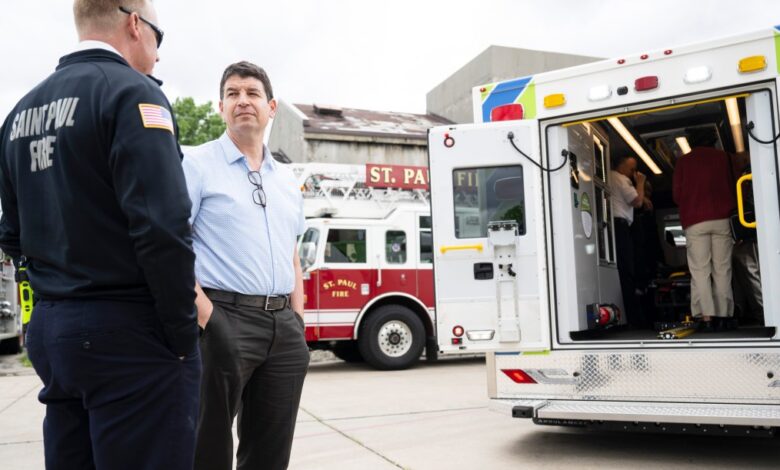Russ Stark, chief resilience officer, on green projects

The symbolic weight of a fully-electric ambulance driving through the streets of St. Paul isn’t lost on Russ Stark, the city’s chief resilience officer. For municipal leaders holding the title, the climate crisis is just that — a crisis — and he’s been tasked with serving as St. Paul Mayor Melvin Carter’s chief adviser on how to respond and adapt.
Still, cities get pitches for fancy — and pricey — innovations all the time, and not all will deliver their intended benefit for the best price. Stark on Thursday had the opportunity to see a first-of-its-kind all-electric ambulance in action when the MacQueen Equipment Group, a private distributor based in St. Paul, held a demonstration at the St. Paul Fire Department’s training facility on Energy Park Drive, the second stop of the Demers eFX ambulance during its national tour.
If the capital city were to deploy these ambulances, which is still a big “if,” St. Paul could be the first city in the nation to do so. Whether Stark will recommend a buy to the mayor remains to be seen.
“We have no imminent plans to purchase one,” said Stark, who has been more focused in recent months on expanding the city’s network of “EV Spot” electric vehicle carsharing stations into the city’s East Side and beyond.
Just weeks after first assuming office in 2018, the mayor tapped Stark, then president of the city council, for a new role in his emerging Cabinet. The move was both sizable and familiar.
Sizable in that getting your arms around the challenge of a rapidly changing climate, and the city’s potential response, can feel existential. Familiar in that Stark, the former executive director of St. Paul Smart Trips and a former environmental justice coordinator with the Clean Air Council in Philadelphia, has been working in related fields his entire career.
And familiar in that his new office was on the same floor of City Hall as his old one.
“I literally packed my boxes and moved across the hall,” he said.

The Inflation Reduction Act
In April alone, Stark sent out requests from the city, or participated in supporting requests through city partners, for some $200 million in federal grant funding tied to the U.S. Environmental Protection Agency’s $5 billion Climate Pollution Reduction Grants program. Those grants have proliferated thanks to the federal Inflation Reduction Act, which has a strong environmental focus. The likelihood that the city will land all of them is slim, Stark acknowledged.
Still, Stark is hoping that with federal grant help, heat from river effluent — the treated water that cycles through the Metropolitan Council’s wastewater treatment plant by Pig’s Eye Lake — can be captured and rerouted into the downtown district energy system, which heats and cools a majority of St. Paul’s downtown buildings.
“If we could get off of fossil fuels, you’re essentially decarbonizing a lot of downtown,” Stark said. “We’ll continue to pursue it even if we don’t get (the federal grant). It will just be on a slower track.”
He’s also hopeful that the electric vehicle charging network he’s been building out with the city of Minneapolis and HourCar will continue to expand. Five new EV Spot charging stations are planned along the coming Gold Line bus rapid transit corridor, and five more stations will be situated on the city’s East Side based in part on community input. With federal help, he’d like to see the St. Paul and Minneapolis network reach deeper throughout the city and into the suburbs.
Also on the horizon are geothermal heating and cooling projects at the future North End Community Center, the Como Park Zoo and in a planned new district energy system at the Heights, the future housing and business development planned at the former site of the Hillcrest Country Club.
Mitigation, resilience
Stark sees his job as advancing the city’s climate and sustainability goals along two major trajectories. The first is to promote mitigation, as in reducing the existing greenhouse gas emissions in the city, and the second is to promote resilience, or “How do we adapt to the ways in which climate is already changing?”
To support those goals, a staff of some 20 employees from across city departments meets monthly as the “Resilient St. Paul” team, examining how to tailor city practices to meet the spirit of the city’s Climate Action Plan, which was adopted by the city council in December 2019.
The plan notes that fossil fuel energy sources are the primary sources of carbon emissions in cities.
“We know that the vast majority of greenhouse gas emissions in St. Paul come from two sectors — the energy that we use in buildings and the energy we use in transportation,” Stark said.
To that end, in addition to geothermal heating, the new North End Community Center could add rooftop solar panels. If that happens, the project would qualify as being carbon-free or nearly carbon-free, in that its carbon offsets likely would exceed carbon production. The future Fire Station 7 on the city’s East Side has been approved for geothermal heating and cooling and rooftop solar, as well.
Stark also serves as the mayor’s eyes and ears on major transportation projects planned by Ramsey County, the Metropolitan Council and other partners, such as the future Riverview Corridor from downtown St. Paul to the Mall of America in Bloomington, the future Purple Line from downtown St. Paul to White Bear Lake, and the state’s Rethinking I-94 initiative.
Geothermal rebates — and critics
Stark’s role hasn’t been without its critics.
“Can’t the mayor and city council do that work?” said Jason George, business manager for the International Union of Operating Engineers Local 49, which represents the heavy construction equipment operators in St. Paul Public Works, St. Paul Regional Water Services and private industry across Minnesota and the Dakotas.
“Can’t you just convert the city fleet to all-electric?” George said. “Geothermal (heating) is great — we’ve had geothermal over at our training facility in Hinckley for 15 years — but do we really need a city sustainability officer to do that?”
Stark points out that it often takes years of policy work, partnerships and advocacy to steer complicated projects such as the EV Spot Network into reality, let alone getting them to expand across city boundaries, which will be key to their appeal for users.
Across the river, the city of Minneapolis maintained a chief resilience officer for several years but has shifted gears, splitting the work among 12 new full-time employees this year as part of the city’s Climate Legacy Initiative. The workers focus on climate and sustainability from within five city departments, ranging from Public Health to Public Works.
‘You can’t convert all the buildings at once’
It’s not just new buildings and transit options that Stark has his eyes on. A federal grant that landed about a year ago will support geothermal installations at the Como Zoo in the primates and polar bears buildings. He’s eager to land federal funding for even more geothermal projects there.
“That Como campus is on an old steam-based boiler system that serves the majority of the buildings,” Stark said. “It’s pretty energy-inefficient. It’s a big system. You can’t convert all the buildings at once.”
Government buildings don’t pay property taxes, making them historically ineligible for environmental benefits that are based on federal tax credits. The Inflation Reduction Act, signed into law by President Joe Biden in August 2022, offers local governments a similar incentive through rebate checks from the U.S. Treasury Department, which allows municipalities to recoup 30% of the cost of a geothermal installation.
“That’s what we expect to get at Como and Fire Station 7,” Stark explained. “But if it’s done on a former brownfield, which the Heights is, you increase that to 40%. If you use American-made materials for the wells and the heat pumps, it goes up to 50%. So we’re anticipating those tax credits could pay for half the geothermal (at the Heights).”
Clean energy transition
The state’s new “Green Bank” — the Minnesota Climate Innovation Finance Authority — has granted a loan to bridge the time from when the equipment must be bought and the time the nonprofit utility is expected to receive its rebate check, which could be three or four years.
“One of the reasons it’s been hard to do these district-wide systems is that someone has to build the system out, and then it’s a while before your energy customers pay in,” Stark said.
More and more, conversations in his circles turn to how best to ensure that the city’s low-income residents and communities of color benefit from environmentally-conscious innovations that have sometimes favored those with the most ability to pay. Electric cars, for instance, are still on average more expensive to purchase than gas cars, though the two in recent years have inched closer to parity.
“We really do a lot of thinking about how, as we do this clean energy transition, that the benefits of that transition are really leading to good workforce opportunities, and reducing energy bills for our lowest-income residents,” Stark said.
In that vein, the city has partnered with the Minnesota Pollution Control Agency on a statewide program aimed at what Stark called “equitable residential decarbonization,” or helping everyday residents reduce fossil fuel consumption in their residences. For instance, tax credits and rebates could put upgraded home electrical panels and at-home chargers for electric vehicles within reach of a greater portion of the population.
All in all, it’s an exciting time in his line of work.
“Far and away, there’s more opportunities to do things now than any time in memory,” Stark said.



